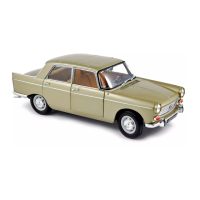-@
,@
---g
/-@
21
20
l9
FIG
10:12
The
masteÍ
cylinder
KeytoFigl0:12
1
Stoplightswitch
2 Washer
3
Banjoconnection 4 Washer 5 Reservoir 6 Springclip
7 Dust
cover 8
Springseat
9 Spring
10 Primarypistonseal 1l Pislon 12 Circlip 13
Stopplate
14
Secondarypiston
seal 15
Stud
'16
Mastercylinderbody
17
Sealingring
18
Sealingring
19
Reservoirscrew
20 Gasket 21 Cap
Do not use mineral oils, or cleaning Íluid extracted
Íronr mineral
oils,
e.9.,
petrol, paraffin,
carbon tetra-
chloride, etc., as they will cause the
rubber
seals to swell
and
become ineffective, The slightest trace
of mineral
oil could soon render the brakes inoperative. Methylated
spirits
or
commercial alcohol must always
be
used for
ílushing
out the system,
washing
brake
housings,
components and any
containers
that come into contact
with brake Íluid.
Any
Íoreign
matter should
be washed
away
Írom
components with methylated
spirits
or commercial
alcohol. lf foreign matter finds
its
way
into
the system
it
may
score
the
pistons
and
damage
the seals, and
will
consequently render the brakes either
wholly
or
partly
inoperative.
Pistons and
seals
should be carefully stored
away
from
grease
or oils and handled carefully at all times. The seals
should be inspected careÍully
beÍore fitting, even iÍ
they
are new.
See
that the sealing lips are
perfectly
formed, con-
centÍic
with
the bore oí the
seal,
íree
from
knife
edges,
surÍace blemishes or marks. Any seal that is
not
perfect,
no matter how minute
the blemish
mav be. should be
88
re.jected.
Seals should not be turned inside
out
when
inspecting
them, since this strains the surÍace
skin and
mav
eventuallv lead to a failure.
All
pistons
and housings must be
carefully inspected
before assembly. Any imperfections
or
scores
on a
piston
or cylinder bore may
provide
a track for fluid leaks under
pressure,
and any damaged
parts
must be
discarded.
Parts must be handled
very
carefully to avoid any
possibility
of accidental scoring.
Prior to assembly, immerse the components
and
parts
in approved brake fluid
to
facilitate fitting and
provide
initial lubrication
for workino surÍaces.
Removing a flexible hose:
Never try to
release a flexible hose by turning the
ends
with a
spanneÍ. The correct
procedure
is as follows:
Unscrew
the metal
pipeline
union
nut from its con-
nection
with the hose. Hold the adjacent
hexagon on
the hose with a spanner and
remove the locknut which
secures the hose to the bracket.
The hose
can
now be
turned without twistrng the
flexible
part.
by using a
spanner on the hexagon on the other end.

